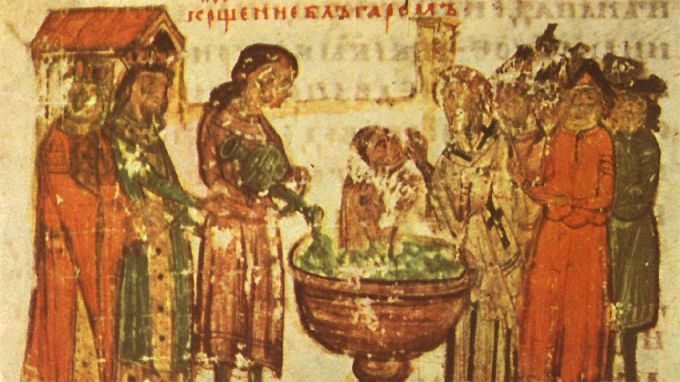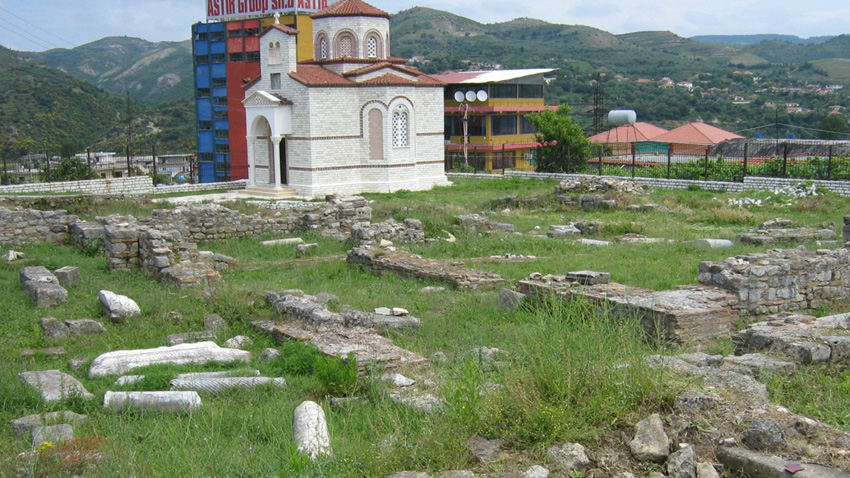
The 100th anniversary of the WWI /1914 – 1918/ is a good occasion the monuments, discovered during that military conflict to be discussed. There is a curious story with Austrian soldiers, who discovered in the beginning of the 20th century the inscription from the city of Ballsh /Southwestern Albania/. The translation from old Greek to Albanian reads: “The Bulgarian ruler Boris, named Mikhail was baptized, together with his people, given to him by God in the year 6 374 /=866 AD/”.
The figure of Knyaz Boris I /9th c. – 907 AD/ was fundamental for the consolidation of the Bulgarian people, consisting in this period of Slavs and pagan proto-Bulgarians. During the rule of Boris I Bulgaria adopted Christianity from the Constantinople Church and the ruler turned it into an official religion with traditions. Such an important event in the Middle Ages can be easily speculated with nowadays. The same thing happened with the inscription from the Albanian city of Ballsh. It is claimed to be, without any historical grounding the medieval Bulgarian area of Glavinitsa. We looked for the expert opinion of Prof. Hristo Matanov from Sofia University “St. Kliment Ohridski”, as he is a renowned contemporary historian, dealing with the problems of the Balkans in the Middle Ages.

Can we consider today’s Ballsh to be the medieval Galvinitsa?
“There are quite a few suggestions on the matter. Glavinitsa hasn’t been localized precisely yet and that is why scientists continue to argue. There are no reasons to consider Ballsh identical to Glavinitsa, though the ruins there testify on the existence of a significant monastery center. The inscription discovered in Ballsh was most likely made by St. Kliment Ohridski. First, it marked the 866conversion to Christianity of the Bulgarians and second – perhaps it framed the diocese of Kliment Ohridski himself.The inscription was not framing a state border for sure. No one can claim that Boris was baptized there. Bulgaria had a capital – Pliska, and the baptizing most likely happened there. Such an important event couldn’t happen somewhere in the periphery of the state – it’s not logical.”
 The Ballsh inscription did not frame a state border zone. There were border inscriptions during the reign of Tsar Simeon the Great /893 – 927/. Those were double, i.e. facing both sides of the border, Prof. Matanov explains. The Ballsh inscription doesn’t look like that.
The Ballsh inscription did not frame a state border zone. There were border inscriptions during the reign of Tsar Simeon the Great /893 – 927/. Those were double, i.e. facing both sides of the border, Prof. Matanov explains. The Ballsh inscription doesn’t look like that.
No other plates with such a text have been found, the historian says. “This shouldn’t be a surprise. A large part of the epigraphic heritage remains scattered or has been used as building material lately. It is the case with the Ballsh inscription. It was found on a column. There is a Latin-like epitaph in its lower end, of a crusader named Robert Dumorfort, who died in Albania in the beginning of the 12th century. Next comes the Ballsh inscription and then comes a cross, placed later on above it.
What is the significance of the Ballsh inscription for historiography?
“The Ballsh inscription is the only domestic one, actually the only epigraphic stone inscription from the baptizing period. There is a Bulgarian note from 907 AD, from Bulgarian scholar Todor Duksov, a relative of Knyaz Boris. He claims that the baptizing took place during the 5th month of the Year of the Dog, which means May 866, according to the Sun Calendar of the Bulgarians. Researchers ask themselves why 866 has been pointed out, as Byzantine written sources pointed at an earlier date.”
Bulgarian history textbooks read that the Bulgarians adopted Christianity in 864/5. However, it means the baptizing of the khan’s family, since a people of several hundred thousands cannot be baptized within a year – it takes two or three. Prof. Matanov says the inscription came to mark the successful ending of the entire baptizing process and second – it registered the successful suppression of the anti-Christian rebellion of the Bulgarian aristocracy.
English version: Zhivko Stanchev
The attack in the "St. Nedelya" cathedral on April 16, 1925 is the deadliest terrorist act in the history of Bulgaria. It took place on Maundy Thursday and in terms of its brutality and premeditation, it has no analogue. During Holy..
On the day of Holy Wednesday, one of the last events before the saving sufferings for humanity of the Son of God is remembered. In her sincere repentance, a sinner managed to enter the house where Christ was staying and, wishing to testify to her..
Holy Tuesday is a day for teachings and final moral instructions. On this day the priests and the Jews listen for the last time to the teaching words of the Son of God in the temple. There, Jesus Christ gives an example of how to give charity –..

+359 2 9336 661
